Quick: name something you can’t put on your TV network for six-year-olds in the United States. “Guns and excessive violence?” That’s old news. “Racism?” Uh, we hope that’s old news. Here are two categories I propose: “things that are nightmarish” and “things that are really gross.”
Let that sink in. Two categories that dominated children’s TV in the 90s and left a long shadow seem to be fading away.
(Also, if you are a kid, please don’t read this, or my PG-13 blog in general.)
Now, I’m not a children’s media buff, nor am I a TV or streaming buff, so I haven’t kept up with anything besides the most general trends. So when I say these things “seem to be fading away,” I’m speaking from the periphery, and I’m focusing on what I know is a falling beast: corporations with a big stake in network television, rather than streaming, YouTube, SpidermanPeppaPigBodyHorrorGate, and so on. I’m speaking as a person who has seen two minutes of Craig of the Creek and Big City Greens, combined. Don’t even know if those are still airing.
Yet if The Owl House or She-Ra had an acid-trip-esque party sequence where characters were shaking their butts at each other, I feel like, sadly, I would know. And the reason I would know is because when that very thing happened in the 2016 reboot of The Powerpuff Girls, random talking heads on my side of the internet were incensed about how disturbing it was and how infinitely they hated this show I didn’t watch. We let Ren and Stimpy do it three decades ago, but the context is radically different.
I am no moral watchdog. I’m just another internet speculator! I’m just saying things that I haven’t heard said, and speculating about why media executives make their decisions because that’s what I like to do.
The thesis of this post: the era of certain kid’s show/movie subtypes and certain kid’s show/movie scenes is gone, or has at least faded out of acceptance. Two of these subtypes are the Nightmarish and the Gross. The other two shall not be named until later. Together they form what I will call the Four Horsemen of the Pretty Unmarketable Apocalypse.
The Nightmarish
When I say “nightmare,” I don’t mean the mystery-solving and conspiracy-unraveling that I associate with 2012’s Gravity Falls. I mean like twisted fever dreams.
Recently, I watched the movie The 5,000 Fingers of Dr. T with a friend. You might expect a movie with significant involvement from Dr. Seuss to be rerun endlessly and lauded as a modern classic, but no, I’d never seen this thing before.
It’s not even bad. Dated, yes. But dated enough to never see the light of day? I dunno, nothing’s stopped TV from showing camp gay villains cowering before the, um, “might” of nuclear family structures before.
We can debate that another time, though. What shocked my friend and I was how genuinely nighmarish this movie was. Let’s start from the fact that it takes place in a literal nightmare. A kid named Bartholomew Cubbins (sorry, I meant Bart Collins, no relation to that other Seuss kid with like a billion hats) falls asleep in the middle of his grueling piano exercises and finds himself in an absolute hellscape. It’s a desolate prison, and its massive sets are empty halls punctuated by the odd gargoylish bird statue or a Seussian hand…which looks a lot more disturbing with real shadow and wrinkles, let me tell you.
But there was one scene early on that my friend and I knew would have destroyed us as children. Bart is trying to escape the gay man’s evil piano lackeys. So, in this world of stark, towering Seuss-stairs and atmospheric matte paintings, Bart runs down what looks like a dead end.
Except that there’s a ladder, which he starts climbing.
Soon we will clearly see that this ladder goes up to nowhere.

He starts climbing up, then he pauses…and looks down.
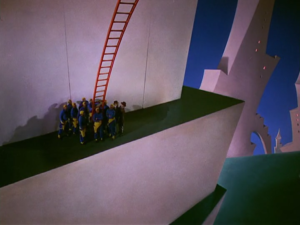
Then he climbs up further. Going nowhere! And the bad guys are just waiting for him. They’re not even shaking the ladder or trying to climb it themselves. It’s like they know what the audience knows.
He looks down again from an even more terrifying height.
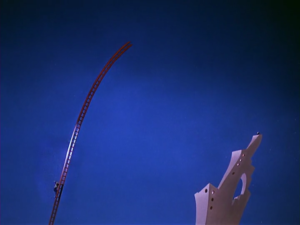
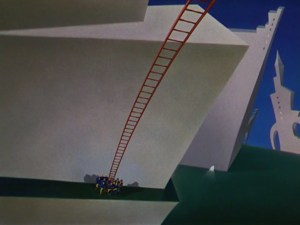
Then, with nothing else to do, he climbs higher…and he looks down AGAIN!
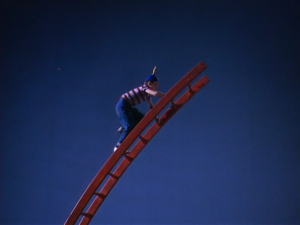
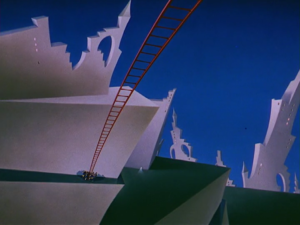
My friend and I were practically in hysterics at this point, not because we were scared, but because we were shocked! I mean, could this be one of the scariest and most bizarre nightmare-scenes in kid’s films?
To me, it was such a convincing child nightmare. There’s something so real and visceral about a “stair dream” or a “ladder dream,” and many of us have had them. I dreamed of falling off an escalator when I was four, and never forgot. I would’ve dreamed of falling off a ladder, too, if I’d seen this damn film. Hell, at that age I got scared when the previews at the beginning of videotapes were too loud.
But The 5,000 Fingers of Dr. T is so old it didn’t come with the G-PG rating distinction, and on the outside it’s just some old generic kid’s movie. “I don’t think films that are this scary should be shown to young children,” my friend said afterward, and that was one of the few times I’ve thought about the relative scariness of the media that we feed kids, or, more likely, that a faceless, anonymous broadcasting station or YouTube channel feeds them.
Ah, I realize I’ve left you hanging about what happened to Bart when he reached the top of the ladder. Did it perhaps swing down and deliver him to the nearest rooftop? Did he get so scared he woke up or something? Nope, he jumped off and…untucked his shirt, causing it to act like a parachute and deliver him safely to the ground. “No! You are dead even in the dream,” my friend said.
Truer words were never spoken.
Such nightmarish things tend to lodge in the memory. Nowadays, across the internet, they are famous for inspiring creepypastas about kid’s shows reimagined or misremembered, as well as lists of the Top 10 Creepiest Kid’s Show Moments From YOUR Childhood.
No piece of media can keep a person from experiencing any nightmares in life—I mean, I never watched The 5,000 Fingers of Dr. T as a kid, but I did see the wall art of my grandmother’s home in shadow, and sometimes that’s enough. But to what extent can children’s media be said to have a responsibility for their psychic well-being? What should we expect from it? What sort of comfort and at what age?
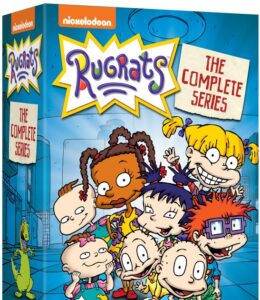
After Rugrats: The Movie expended that franchise’s budget for moody lighting and creepy rain monkeys forever, the Rugrats TV show became safer, but also, well, boring. In my eyes, the chance for deeply resonant art, or even just chuckles, was lost. But as I grow older, I, like my mother, see more and more the appeal that a safe and comforting show can have as a refuge for viewers of any age. Instead of making a Nostalgia Critic-style rant about how these later seasons “failed as entertainment,” I begin to wonder if that refuge-ness is what the showrunners were consciously going for.
I also have a theory that once TV executives get wind of some of these Top 10 Creepiest Moments lists, they realize that nightmares are not always marketable. Sometimes all controversy is good controversy, but other times, no news is good news. If I’m five and my parents just read a headline saying that Rugrats is no longer a good show for developing minds, even if that article was written by Dr. Lipshitz himself, my parents are probably erring on the side of caution. Meaning the network gets one less viewer.
The Gross
I have rarely seen proof that anyone likes Sanjay and Craig, or indeed ever liked it.

This cartoon about a boy and a talking snake ran from 2013 to 2016. That means it premiered when I was 15, and at that age the main things keeping me on network television were Tim and Eric, Awesome Show, Great Job!, curiosity about the new Animation Domintation HD block on Fox (RIP…you tried, mates), this one Korean drama about a duck farm called Ojakgyo Brothers, and, of course, reruns of All in the Family.
As you can tell by…maybe the first half of those examples, I had great interest in “shows for stoners.” No one in my life would call them that, but I know tons of people out there must. Shows that are supposedly best experienced when you’re kinda zonked out and in the mood to see something very weird.
I appreciated a show that was willfully weird and swung for the fences even when it failed—in fact, that failure made the hits more surprising. So for every failed punchline of an adult cartoon like Axe Cop, I got an unforgettable moment like Baby Man dancing. (It was truly unforgettable and you just have to trust me on that.)
And I think that was why I was drawn to Sanjay and Craig. It had a lot of stale jokes, a lot of boring episodes, but it also had moments of glory. Who can forget “Muscle C.O.P.S.” where Sanjay and Craig get to hang out with dudes who are all absurdly muscular with one specific body part, like not the leg but specifically only the hamstring of the leg??
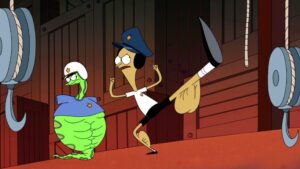
…Okay, I did forget mostly everything I’ve seen from this cartoon. But look, it’s still important to me somehow. Also, because I just think it’s neat, I will let this go down in history as, perhaps, the only website on Earth to say it: could this be the first Nickelodeon cartoon starring a mixed protagonist? (Probably not, but…maybe?) Is his dad Vijay the first Nick cartoon character who has an Indian accent AND isn’t a walking joke (I’m looking at you, Other Sanjay from Fairly OddParents)? And is it possible that Sanjay’s friend Hector is the first Ralph-Wiggum-looking character with an eyepatch who isn’t made fun of for looking kinda like Ralph Wiggum OR for having an eyepatch??
Apparently, when the characters Sanjay and Craig were first conceived by Will McRobb and Chris Viscardi (who I assume don’t have Indian heritage), it was as a snake charmer team. At some point in the process, someone must have let them know, “Oh…this is a terribly orientalist concept for a children’s show by two white dudes, and it won’t age well.” They reference snake charming briefly in the theme song, and then that’s it. The show’s core conceit was changed, and the world smiles for it.
But you know what the world doesn’t smile for? Grossout cartoons.
Yes, for that is a popular name for the disgusting, fart-happy cartoons that, by and large (at least in the United States), arose in the 90s. Maybe Sanjay and Craig doesn’t have some outwardly gross cast like, to make a particularly shameful example, Super Duper Sumos (whose whole gimmick is that they’re big and they won’t stop, as Baby Man put it, “shaking what their baby gave them”). But it does have episodes with names like “Fart Baby,” “Butts Up,” and “Laked Nake.”
I think that as a kid, I was neutral and nonplussed by toilet humor on TV. It wouldn’t draw me in, but neither would it push me away. I watched many an episode of Ren and Stimpy, which was among the very first of this particular era of gross cartoons for kids. But while it’s a known fact that various kids at various stages are very curious about scatological things, it ain’t all kids all of the time.
Not only will many kids age out of it, but it seems that the whole market has too, at least for now. (Maybe they’re leaving that to horribly exploitative YouTube videos! I hope those stopped after this article was published. But they probably didn’t.)
But also, I’m not sure TV execs like thinking that collective interest in the Sanjay and Craig brand is waning because too many YouTubers are eschewing “this cartoon is a funny one I liked it” for “‘Fart Baby’ is the worst, grossest concept for a TV episode I have ever seen.” That’s a quote I made up just now, but if you search for “sanjay and craig review” you’ll see how mixed the reception has been and find many people disappointed by the crude humor.
Naturally, the target audience for this show wouldn’t be The Mysterious Mr. Enter or other adult YouTubers. It was probably elementary- and middle-school students, along with their parents, who might have the gross but necessary memories so many parents obviously have of raising and potty-training their loved ones. The humor will hit them differently. All the same, I think that as that child audience grows older, into adults but not all into parents, they’ll find Sanjay and Craig harder to go back to because that disgustingness will now be the barrier to entry.
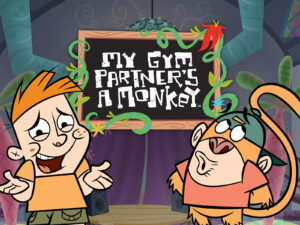
I believe there tends to be some gradient for this. Kids tend to go from positive to tolerant, then neutral, intolerant, or just disappointed. Thus, when I was nine, I blankly watched episodes of My Gym Partner’s a Monkey, which uses said gym partner’s monkey status to justify way, way, way…just way too many butt jokes. But then one night when I was ten, my sibling and I were turning on the TV, stoked to return to the world of cable after a big move.
We landed in the middle of a My Gym Partner’s a Monkey episode. There was a conference of monkeys, and instead of waving their hands in the air, they were all waving their feet. My sibling and I looked at the screen full of butts, then at each other (and our mother), and wondered why we were watching this.
It seems like everyone loves Spongebob—but, notably, not for the time he shits his pants. In fact, in hindsight, we might have done without that one. (Yes I said “shits” not “splits.”) But then you go farther down the grossout scale…way farther. And then you realize that no one is willing to go back to Cow and Chicken. (Correction: they may take the risk for the sake of The Red Guy, but they never go back for Baboon.) Even fewer, and I’m talking in the negatives, would dare try Mega Babies. Even Ren and Stimpy’s not sitting comfortably in today’s collective memory. Part of that is the scars of a failed reboot and one infamously awful showrunner (who, much like the other Two Horsemen, will not be named here), but people are also looking back and saying, “Somehow butts aren’t as funny as they used to be.”
I conclude that the gross factor of these cartoons simply is not aging well. And the more I squint at it from here, the more the grossness becomes one and the same with the marketing trends running from the 90s through to the mid-2010s. You can probably argue that the general “softness” of many cartoons today is one and the same with what’s trendy today. I think it’s all true, and that, at the same time, this doesn’t void the shows or their styles of value.
All the same, it’s become clear now that grossness for grossness’ sake gets in the way of good jokesmanship.
Is it healthy for child minds? Only Dr. Lipshitz can say for sure. How could I possibly have found it wholesome for my teenage mind back when I digested Sanjays and Craigs? I think that while by age ten I was slightly prudish, the combined forces of Tim and Eric and game reviews by the Angry Video Game Nerd had so thoroughly eroded any of that over the course of five years, magnifying-glass-burning-paper-with-the-sun-style, that by the time I saw “Fart Baby,” I was proud to be able to say, “This is heartwarming in a bizarre way, and that’s exactly what the creators intended.”
But seriously, I don’t like the idea that if I ever want to make a Top 10 list of the best Sanjay and Craig episodes or something, I have to see Sanjay walking in on Noodman’s cat using the toilet, again. We could have done without that one.
Two additional facts before I move on:
- You know the glory days of gross cartoons are gone when a show like Clarence, whose character designs are janky and snaggletoothed, and outwardly weird, and look like they would be unwholesome, and are in a smelly preschool…doesn’t have any grossout jokes. Not in the several episodes I’ve watched, anyway.
- Beyond the title, the show Butt-Ugly Martians features, to my knowledge, no butt humor. Could this quite possibly be the greatest, most tasteful show of the 90s?

Two More Horsemen: Frightening F-Words, But Not the Ones You’re Thinking Of (…Still, Kids Please Leave Already)
I held off on mentioning these two horsemen because I knew that if I started the article with them, you’d quit reading as surely as I quit watching My Gym Partner’s A Monkey that fateful night. Nightmarish imagery and gross school lunches might have TV producers quaking in their boots, but they’re only one half of this grand Venn diagram, and in the middle of that diagram will be found the most disgusting and unairable (in 2023) children’s programming of all time…and finding that program is a job that I will leave up to stronger minds than my own.
Now I will dare to go where none have gone before. Unlike anyone on the internet before me, ever, throughout time, I am about to talk about
Furries
Ever since the furry fandom/subculture got a spotlight episode on fucking CSI, and in 2003, people have been a-hooting and a-hollering about them like the jokes hadn’t originated two decades ago. For the uninitiated, furries are people who like anthropomorphic animal characters. Some of them literally just think Sonic the Hedgehog’s design is cool. Others (the ones that people will not stop making fun of) are aroused by some of these characters.
For obvious reasons, a TV executive does not want their children’s cartoons to have even a rumored connection to a group with “aroused” in their definition, no matter if that proportion of furries is 10% or 0.00001%. I think that’s why you won’t see Disney making character designs like the ones in their Robin Hood again anytime soon: that two-legged-fox interpretation of Robin Hood looks a lot like what has now become “the furry art style” that dominates furry-centric parts of the internet. Not even Zootopia and BoJack Horseman are getting that close.

Thus, when the internet at large looks back at cartoons with “furry characters” from time to time, it’s often with confusion, distress. The Nostalgia Critic asks why Lola Bunny in the original 1996 Space Jam has “bunny boobies.” Other aspects of this character are also played up for “sex appeal.” Should a PG-rated film really be doing that for a cartoon rabbit, whether tongue-in-cheek or not? The general response is “um, no, certainly not,” and surely the adult fan artists who are most interested in seeing such a thing can draw that themselves.
I believe it is by no coincidence that Lola’s redesign in 2021’s Space Jam: A New Legacy does not have the “boobies.” And I think it’s unsurprising that anthropomorphic characters in later shows like Amphibia and Centaurworld have deliberately unrealistic, inhuman proportions.
They’re trying to scare the furries away.
But will it work?

F-rankly Disturbing Body Deformations
You know the gag where a cartoon character gets crushed by a steamroller or something, but they’re still alive, actually, they’re just really flat now?
I think this was intended to be the exact inverse of a nightmare. In real life, this would be horribly grisly and sad. But if the character gets flattened and is alright after a quick cutaway, it’s all good and we’re just having fun. Of course, there are numerous other Looney Tunes-type gags that serve the same function that I could jot down and you could too.
I’m convinced, though, that this stuff caused some unintentional nightmares, a new breed of nightmares, and no shortage of thoughts equivalent to, “What the heck? But that’s still disturbing, just in new ways!”
You understand what I’m driving at, right? Imagine being crushed flat, rendered unable to move, never able to re-enter society as we know i—WOAH, hang on, this is getting too pornographic.
That’s right. Along with furries, this frankly disturbing body deformation is another unexpected source of arousal for some people. The proof is scattered here and there across the vast internet, across many cartoonish deformations that can become oddly specific. I hand you the keys; now it’s up to you to do what I did and go look up all the lists with names like Top 10 Fetishes YOU Didn’t Know Existed Online.
Why do these wires get crossed in this way? Why this? Why furries? And why can’t Freud give us a good clean answer? We may never know (although the answer to the latter is probably because he stopped practicing many years ago.)
But in an attempt to examine some potential root causes, I would like to look at a frankly disturbing scene that intersects with nightmarishness. For the record, this scene was chosen because I have yet to see “foot-curling-up-under-house fetish” online. (I mean, there’s probably a web portal for it, but don’t show it to me, I’m not ready.) What I have seen is people agreeing that the scene was creepy, excessive, and did not further the plot at all. It has become lodged in collective memory.
Let’s look at the scene in The Wizard of Oz where Dorothy becomes a murderer.
When Dorothy’s house falls from the tornado and crashes down into Oz, it hits the Wicked Witch of the East, killing her instantly before Dorothy has even opened her front door. Of course, we don’t learn this the instant she makes landfall; the revelation only dawns on her when Glinda the Good Witch and her insistent smiles points out “hey, you killed her, good!”
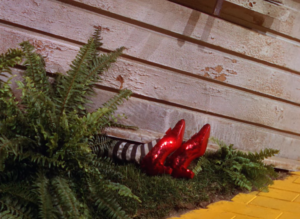
This alone is conceptually terrifying. But when the Wicked Witch of the West comes knocking in search of her sister, she watches (alongside a horrified/befuddled Dorothy and the viewer) as the witch’s feet lose their ruby slippers and curl up under the house.
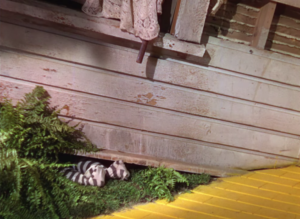
Nightmarish. Creepy. Weird. Makes no sense. Runs on dream logic. Would be bone-crunchingly awful if it happened in real life. Even worse, it’s morally horrifying: Dorothy is a murderer and she didn’t even know what she was doing—she never even met this broad and now she’s dead. Worse, the Good Witch and the Munchkins of the village all congratulate her for this violent act. Thus, the cheerful musical number. She killed and we are all smiling and laughing because of it. She wears the slippers of the damned. To make the scene more bizarre and further remove the humanity of the Wicked Witch of the East, it’s literally impossible to see this witch’s face, both because it’s buried under the porch and because all the characters willfully leave her there.
Man, it’s bad enough when Bart Collins climbs a ladder to nowhere and keeps looking down. But if somehow he’d also been transformed, a visceral element would have been added, a way to make the scene stick in the body the way a nightmare can stick in the mind. And then there’s the moral-ambiguity element. If the show or movie asks questions that the plot itself won’t put to bed and that nobody in the child’s life really cares enough to answer (i.e. nobody fucking cares about the Wicked Witch of the East and how her feet curl up, because in short order Dorothy moves on to following the Yellow Brick Road), then that can leave the questions in the child’s subconscious. The little nightmare is unresolved, and now it’s up to the young mind to study it like some pointless philosophy lesson.
And if it happened in Disney’s Robin Hood and Robin Hood was also made in the gross 90s or 00s, then it would have just been a recipe for disaster.
Conclusion
Right, so my ultimate thesis is that Nightmares, Gross Things, Furries, and F-rankly Disturbing Body Deformations comprise the Four Horseman of a Pretty Unmarketable Apocalypse.
They tend to produce all the outcomes that marketing executives (and apparently others) do not want—which ultimately come down to shows not aging well, attracting the wrong publicity, or simply not keeping the desired audience and attracting a periphery demographic that may possibly skew older or hornier or stoner-er instead.
I guess the only lesson to be taken from this is that if you’re a parent or guardian, and if you have the time and bandwidth to invest in previewing the media your children are taking in, it’s worth the investment. You can’t necessarily make a spotless judgment call about whether or not your child is too young and impressionable to see dead witch feet curling up, but some decisions are easier—for a more reasonable example, maybe you’re interested in streaming a family movie that features a divorce, but you’re concerned about how that divorce is framed. That will have a more predictable effect on a child’s subconscious ideas than, well, anything else I’ve mentioned.
Also, when you can, talk to your children about how they feel about the programs they’re engaging with. Do they actually like what’s on, or did you just assume they do because they’re staring googly-eyed at whatever the screen happens to be playing? Does something about it annoy them, or did they take an unintended lesson from it? And will they need a security blanket tonight?
Thank you for reading, and Patrons, thank you for Patreonning.
If you have now been thoroughly convinced that media literacy is important (or at least can be wacky), might I recommend reading my thoughts on The Polar Express, which is pretty weird also? Or my thoughts on this cool fantasy novel you’ve missed out on called Pyrebound? Come on, step it up!

You didn’t mention that one episode of Invader Zim where Zim gets a giant zit and discovers it has hypnotic powers. He tries to pass it off as his friend “Pustulio” and take it to school but long story short Dib pops it and covers the floor in rancid pus which he is then tasked with cleaning using the smallest possible sponge. Possibly other episodes of Invader Zim were also this gross but that’s the only really gross one I remember. Though there were gross details here and there, because Jhonen Vasquez was involved.
… anyway, that was a thing too.
I do dimly remember that one. Eeeugh. And I think you’re right about that one being the only outrageously gross one among a sea of slightly gross ones. I think I missed it in its heyday and didn’t see reruns often, but that DVD out the DVD rental store, man. Pretty good stuff.
What looms larger in my mind as a show I missed, mostly because it was on TV longer and had more billions of episodes, is The Grim Adventures of Billy and Mandy. It would be COMPLETELY unfair to call that “Cartoon Network’s answer to Invader Zim” and yet the tone and horror of its early episodes make it feel almost like a strategic competitor. Also like ten times more gross than Invader Zim.
Meanwhile, someone else told me I overlooked Courage the Cowardly Dog and…Totally Spies.